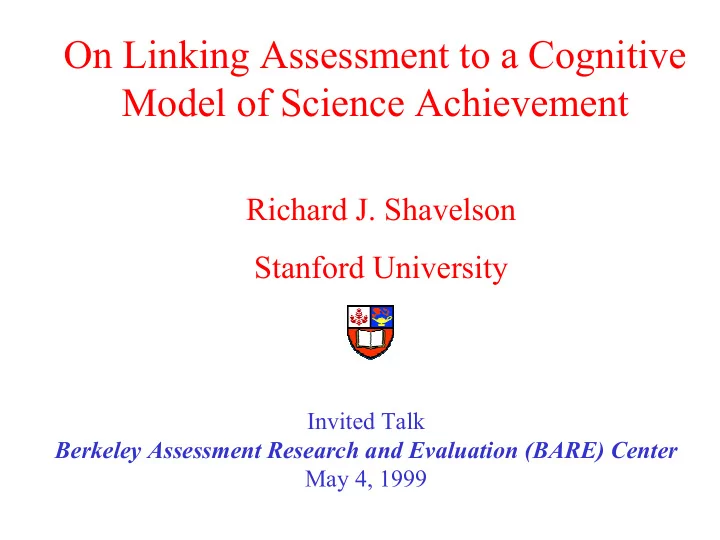

On Linking Assessment to a Cognitive Model of Science Achievement Richard J. Shavelson Stanford University Invited Talk Berkeley Assessment Research and Evaluation (BARE) Center May 4, 1999
Overview of Talk • What does it mean to “achieve” in science? • How might we measure achievement in science? • What evidence is there that we’re measuring different aspects of achievement? • What remains (or what doesn’t remain!) to be done?
Toward An Achievement Framework: Knowledge Components Declarative Procedural Strategic Knowledge Knowledge Knowledge Characteristics That Vary According to Proficiency (Knowing the “ that ”) (Knowing the “ how ”) (Knowing the “ which ,” Level “ when ,” and “ why ”) Low High Extent ( How much? ) Domain-specific Production Problem schemata/ content: system-- Structure • facts strategies/ condition- ( How is it organized? ) • concepts action rules • principles operation systems Others (Precision? Efficiency? Automaticity?) Cognitive Cognitive Tools: Tools: Planning Planning Monitoring Monitoring
Linking Assessments to Achievement Components Declarative Procedural Strategic Knowledge Knowledge Knowledge Performance Performance Extent Multiple-Choice Assessments Assessments Conceptual Models/ Procedural Structure Maps Mental Maps Maps Others
Declarative Knowledge: Multiple-Choice--TIMSS Pop. 2 Air is made up of many gases. Which gas is found in the greatest amount? A. Nitrogen B. Oxygen C. Carbon Dioxide D. Hydrogen
Structure of Declarative Knowledge: A Concept Map of a Concept Map! Concept Map Concept Map is a graph consist of consist of labeled labeled nodes linked by lines lines represent denote a between a pair of concepts relation
Structure of Declarative Knowledge: Eleven-Year-Old’s Concept Map rain is falling water water comes from contain contain clouds goes soil rivers into rivers flow to oceans sun shines on From White & Gunstone: “Probing Understanding” (1992, p. 16)
Procedural Knowledge: Performance Assessment: TIMSS Pop. 2 PULSE At this station you should have A watch A step on the floor to climb on Read ALL directions carefully. Your task: Find out how your pulse changes when you climb up and down on a step for 5 minutes. This is what you should do: • Find your pulse and be sure you know how to count it. IF YOU CANNOT FIND YOUR PULSE ASK A TEACHER FOR HELP • Decide how often you will take measurements starting from when you are rest. • Climb the step for about 5 minutes and measure your pulse at regular intervals. 1. Make a table and write down the times at which you measured your pulse and the measurements you made. 2. How did your pulse change during the exercise? 3. Why do you think your pulse changed in this way?
Procedural Knowledge: Performance Assessments for FOSS Curriculum release position
Types of Tasks and Scoring Systems Type of Assessment Task Type of Assessment Task Scoring Scoring System System Component Comparative Classification Description Others Identification Investigation • Paper Towels Analytic Analytic • Bugs • Incline Planes Procedure- • Friction Based • Bubbles Evidence- • Electric Mysteries Based • Mystery Powders Dimension- • Rocks and Charts Based • Sink and Float Data Accuracy- • Day-Time Based Astronomy ? Others Holistic Holistic • Leaves (CAP Assessment) Rubric ? Others
Strategic Knowledge: Mental Models(?) • What causes day and night? A. The earth spins on its axis (.66) B. The earth moves around the sun (.26) C. Clouds block out the sun (.03) D. the sun goes round the earth (.04) Source: Sadler, P.M. (1998) Psychometric models of student conceptions in science: Reconciling qualitative studies and distractor-driven assessment instruments. JRST, 35(3), 265-296.
Strategic Knowledge: Mental Models • (A) A rocket is moving along sideways in deep space, with its engine off, from point A to point B. It is not near any planets or other outside forces. Its engine is fired at point B and left on for 2 sec while the rocket travels from point B to point C. Draw in the shape of the path from B to C. (Show your best guess for this problem even if you are unsure of the answer.) • (B) Show the path from C after the engine is turned off on the same drawing. A B A B C C Correct Incorrect Source: Clement, J. (1982). Students’ preconceptions in introductory mechanics. American Journal of Physics, 50(1), 66-71.
Some Empirical Evidence: Links between Knowledge and Measurement Methods Correlations from Shultz’s Dissertation (N=109 6th Graders Studying Ecoology): – CTBS Reading and M-C: 0.69 – Reading and Concept Map: 0.53 – Reading and Performance Assessment: 0.25 – M-C and CM: 0.60 – M-C and PA: 0.33 – CM and PA: 0.43
Some Empirical Evidence: Other Evidence • Correlations (covariances) tell you about relative rank ordering on different measures--that’s only part of the story • Evidence is needed for the cognitive claims that different methods measure somewhat different aspects of achievement: – Talk aloud – Focus group – Group work – Other?
Cognitive Validity Framework Comparing assessment tasks on three dimensions Inferred Intended Scores Cognitive Task Obtained Activity Demands Congruence Congruence
Talk Aloud with Concept Maps: Method Variation Correspondence Between Directedness and Inferred Activity 0.6 0.5 Proportion Scores 0.4 Low Directed 0.3 Contruct-A-Map Fill-In-Nodes Fill-In-Lines 0.2 High Directed 0.1 0 Explanation Monitoring Conceptual No-Code Errors Verbal Codes
Talk Aloud with Concept Maps: Performance Level Fill-In-The-Nodes Construct-A-Map 0.8 0.8 0.7 0.7 0.6 0.6 Proportion Scores Proportion Scores 0.5 0.5 Teachers 0.4 0.4 High 0.3 0.3 Low 0.2 0.2 0.1 0.1 0 0 Explanation Monitoring Conceptual No Code Explanation Monitoring Conceptual No Code Error Error Fill-In-The-Lines 0.8 0.7 0.6 Proportion Scores 0.5 Teachers 0.4 High 0.3 Low 0.2 0.1 0 Explanation Monitoring Conceptual No Code Error
Future Directions • Does the distinction between knowledge types and a working definition of achievement make any sense? • How defensible are the links between measurement methods and knowledge types? • What other measurement methods tap into these knowledge types? • How can we measure mental models on a large scale?
Recommend
More recommend